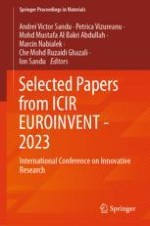This book is a collection of research papers presented at the International Conference on Innovative Research, a part of EUROINVENT 2023, held under the patronage of Romanian Ministry of Research Innovation and Digitization. The book features contributions from leading researchers, engineers, and students who have presented their insights and experiences on a wide range of topics in the field of Materials Science and Engineering. The papers cover advancements, innovations, and future directions in the field, and are grouped into sections based on the themes discussed at the conference. The book is a valuable resource for researchers, students, and professionals interested in the latest developments in materials science and engineering.
